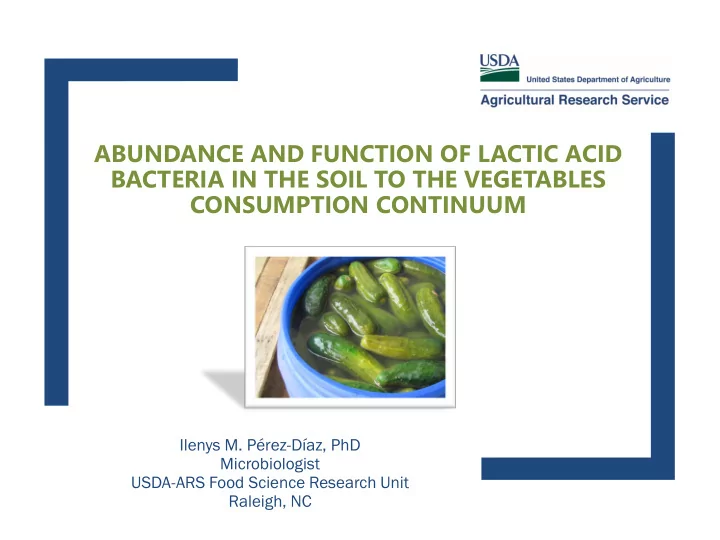

ABUNDANCE AND FUNCTION OF LACTIC ACID BACTERIA IN THE SOIL TO THE VEGETABLES CONSUMPTION CONTINUUM Ilenys M. Pérez-Díaz, PhD Microbiologist USDA-ARS Food Science Research Unit Raleigh, NC
Oppor ortunit itie ies t to o dis isco cover er biof iofunct ctio ions ns in in LAB LAB that at co coloniz onize plant ants, f , foo oods and and the e human g gut ut ■ Mic icrobes in in Plants – Microbial diversity on fresh vegetables primarily derives from the soil. A low incidence of lactic acid bacteria occurs in fresh vegetables. ■ Mic icrobes in in Ferm rmented Vegetables – Lactic acid bacteria consistently prevail in vegetable fermentations. ■ Mic icrobes in in the H Human Gu Gut – Lactobacillus plantarum will continue to be central to the ability of fermented vegetables to deliver beneficial health effects.
Cuc ucumber Microbi biome Fermented F Fruits Harvested F Fruits -Early Fermentation: - Rhizobium, Pseudomonas, Pantoea, Pseudomonas, Stenotrophomonas, Comamonas , Seed eds (59 isolated Pantoea, & Acinetobacter , Wautersiella , cultures) Stenotrophomonas Microbacterium , Flavobacterium , -Dried Seeds: Enterobacter, Ochrobactrum, (Pérez-Díaz and Citrobacter and Kluyvera Bacillus & others, 2018. Paenibacillus (Pérez-Díaz and others, 2018. Int. J Rhizos osphere e effect Int. J Food Microbiol. Food Microbiol. Submitted) -Residual placenta and Submitted ) -Soil: Bacterioidetes & fruit pulp: - Active Fermentation: Actinobacteria Lactococcus , Lactobacillus pentosus , Lb. -Rhizoplane: Rhizobium , Cronobacter , Pantoea , plantarum , Lb. brevis , Weissella Cellvibrio , spp., Pediococcus ethanolidurans , Enterobacteriaceae & Saccarophagus , Devosia , Leuconostoc spp. and Lactococcus Pseudomonas Pseudomonas spp. -Fresh Seeds: (Ofek and others, 2014. (Pérez-Díaz and others, 2017. Food Microbacterium Env. Microbiol. 16(7) Microbiol. 63:217) (Khalaf & Raizada, 2157) 2016. BMC Microbiol. 16:131)
Microbes in Fresh Cucumbers 100 Average OTUs Relative 80 Abundance (%) 60 40 20 0 Mini Pickling Super Select Long English Average Fresh Cucumber Type Clavibacter Sphingobacterium Aureimonas Rhizobium Sphingomonas Oxalobacteraceae; Other Citrobacter Klebsiella Pantoea Acinetobacter Pseudomonas Stenotrophomonas Methylobacterium Average < 1% The core bacteriome of fresh vegetables including fresh cucumbers, corn, cabbage, carrots, spinach and peas is composed of two taxonomical families, Enterobacteriaceae and Pseudomonadaceae (Lopez-Velasco et al., 2013; Manani et al., 2006; Samish and Etinger-Tulczynsky, 1962; Shi et al., 2009; Weiss et al., 2007).
Symbiotic relationship between plants and microbes Pl Plan ants E Evolve t to: Mic icrobes Co Contribute t to: ■ Select Beneficial Microbes ■ Growth (auxin hormone) ■ Maintain Beneficial Microbes ■ Development ■ Sustain Valuable Microbes ■ Defense Dried se seeds, s, ri richer r in in oi oil (50% (50%), p protein (35% (35%) and D DNA are a an imp mporta tant v t vectors of of mic icrobial ial d div iversity f for pla lants, s, flo lowe wers a and fruits ( (Lemanc nceau et al. l., 2 , 2017). .
Examples of microbial functions in plant systems Micro robes Fu Function Outcome Reference ce Pseudomonadaceae degrade plant cell wall enables the microbe to DeBoy et al., (20% of the rhizoplane components and other complex penetrate and colonize the 2008 population) polysaccharides plant tissue Bacillus nitrogen-fixation and conversion of Nitrogen gas DeBoy et al., scavenging, deaminase activity into a solid and usable form 2008 and protease, pectinase or cellulose activity Bacillus spp., phosphate solubilization through availability of Phosphate Khalaf and Enterobacteriaceae and the production of organic acids Raizada, Lactic Acid Bacteria or phosphatases 2016 Enterobacteriaceae and produce auxin and siderophores plant growth hormone and Khalaf and Pseudomonas iron chelation Raizada, 2016 Bacillus species isolated from cucumber seeds cluster apart from Bacilli isolated from other cucurbit seeds (Khalaf and Raizada, 2016). Bacillus species isolated from cucumber seeds cluster apart from Bacilli isolated from other cucurbit seeds (Khalaf and Raizada, 2016).
Lactic acid bacteria response to various stresses on the vegetation results in: ■ nutrient enhancement ■ stress reduction ■ and consequently plant growth promotion (Filannino et al., 2018) Concomitantly, the plant produced food is enriched in bioavailable and bioactive compounds.
Fermentation serves as an instrument to pre-adapt beneficial microbes indigenous to fresh vegetables to: ■ The acidic pH characteristic of the colon ■ The high lactic acid concentration present in the colon ■ The metabolism of dietary fiber, particularly pectic substances naturally present in the plant material and the gut. ■ LAB from plants augment the catalog of metabolic functions needed in & available to the gut for building resilience in a healthy individual.
LAB are naturally present in Human ■ Human Body 10 14 ■ Stomach 10 7 ■ Lower Small Intestine 10 7 ■ Colon 10 11 10 4 to 10 5 ■ Skin 10 4 to 10 5 ■ Saliva 10 4 to 10 5 ■ Dental plaque 10 4 to 10 5 ■ Upper Small Intestine (Sender et al., 2016) The number of LAB rarely reach 10 9 CFU/g in a fermenting vegetable, ■ which translates into 0.001% of the gut microbiota. ■ Lb. rhamnosus , Lb. ruminis , Lb. delbrueckii , Lb. plantarum , Lb. casei and Lb. acidophilus are among the 58 lactobacilli species that have been found in human feces at densities fluctuating between 6 and 8 log CFU/g (Rossi et al., 2016).
Many studies have been conducted to elucidate the mechanism by which Lb. plantarum could impact human health ■ Several strains of Lb. plantarum contain genes coding for molecules and systems potentially responsible for the stimulat ation of an anti- or pro-in inflam ammat atory y immune response in the gut (Hemert et al., 2010). ■ Strains of Lb. plantarum isolated from various fermented vegetables are able to sur survive in simulated gastric and intestinal conditions, adhere to intestinal Caco-2 and HT29 MTX cell tissues, cat atab abolize fructoligosac acchar arides as the only y car arbon source an and cholesterol, an and in inhibit it p pat athogens from hum uman n so sour urces (DeAngelis, 2017; a review).
■ Lets talk. ■ Ilenys M. Pérez-Díaz, PhD – Ilenys.Perez-Diaz@usda.gov – (919)-513-0165
Recommend
More recommend